Manson at the Movies
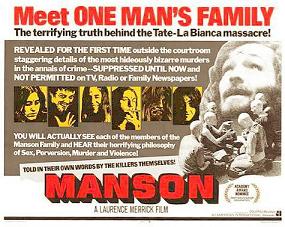 August 2009 marks the fortieth anniversary of one of the most bizarre series of murders in American history. In the early morning hours of August 9, 1969, members of a group known as “The Family”, acting under the instructions of their leader, Charles Manson, invaded a secluded mansion in the Benedict Canyon area of Los Angels. Later that day, the bodies of actress Sharon Tate, wife of director Roman Polanski who was eight and a half months pregnant with his child, coffee heiress Abigail Folger, Hollywood hairstylist Jay Sebring, Wojciech Frykowski, and Stephen Parent were all discovered brutally murdered.
August 2009 marks the fortieth anniversary of one of the most bizarre series of murders in American history. In the early morning hours of August 9, 1969, members of a group known as “The Family”, acting under the instructions of their leader, Charles Manson, invaded a secluded mansion in the Benedict Canyon area of Los Angels. Later that day, the bodies of actress Sharon Tate, wife of director Roman Polanski who was eight and a half months pregnant with his child, coffee heiress Abigail Folger, Hollywood hairstylist Jay Sebring, Wojciech Frykowski, and Stephen Parent were all discovered brutally murdered.
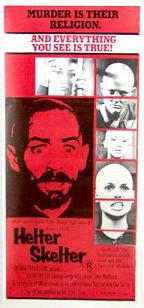
OLYMPUS DIGITAL CAMERA
That evening, as news of the Tate murders was blanketing the country, a similar group of Family members, this time lead by Manson, traveled to a suburban area on the outskirts of Los Angels. After gaining access to a Waverly drive home, Manson left his followers to savagely murder supermarket executive Leno LaBianca and his wife Rosemary. Their bodies were discovered the following night by their children.
The brutality, senselessness, and seeming randomness of the murders made the police investigation difficult and sent the country, especially California, into a panic. It would take four months before enough of the pieces of the puzzle were put together to charge the assailants with the crimes and almost another year for them to be tried. The motives behind the killings were almost as bizarre as the crimes themselves and involved a race war, hidden messages in the Beatles music, and the eventual end of civilization as we know it. The events of the Tate-LaBianca Murders and the Manson Family have passed into true crime history and are still being studied to this day.
Never being one to miss an opportunity to benefit from public infatuation and speculation, filmmakers immediately rushed into production on every kind of film imaginable. These ranged from exploitative documentaries to factual dramas and quick cash-ins that offered very little in the way of information or entertainment. For the next several years, theater audiences would be bombarded by films, sometimes more than once, that promised to show them the gory details the news could not.
The Helter Skelter Murders (1970)
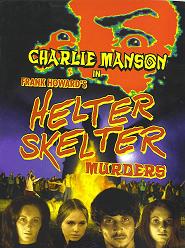 The only positive thing to be said for this pseudo-documentary is that is was the first of the Manson exploitation films to make it to the screen. Originally released as The Other Side of Madness, the “madness” was probably on the part of theater audiences who realized they had just spent their hard earned money on this piece of junk. This predominantly black and white film, with a few color sequences, purports to show the events of the Tate-LaBianca murders as they happened. What we really get is an incredibly boring court room drama with minimal synchronized dialog and riddled with pointless flashbacks that do little more than pad out the running time to theatrical length. Since most of the actual details of the murders were still being sorted out while this film was being made, the producers were forced to rely on newspaper speculation for the majority of their information and making up or ignoring the missing pieces. This film belongs in the filmmaker’s handbook under the section titled “Cash-Ins” and should be avoided at all costs.
The only positive thing to be said for this pseudo-documentary is that is was the first of the Manson exploitation films to make it to the screen. Originally released as The Other Side of Madness, the “madness” was probably on the part of theater audiences who realized they had just spent their hard earned money on this piece of junk. This predominantly black and white film, with a few color sequences, purports to show the events of the Tate-LaBianca murders as they happened. What we really get is an incredibly boring court room drama with minimal synchronized dialog and riddled with pointless flashbacks that do little more than pad out the running time to theatrical length. Since most of the actual details of the murders were still being sorted out while this film was being made, the producers were forced to rely on newspaper speculation for the majority of their information and making up or ignoring the missing pieces. This film belongs in the filmmaker’s handbook under the section titled “Cash-Ins” and should be avoided at all costs.
Sweet Savior (a.k.a. The Love-Thrill Murders) (1971)
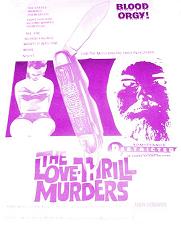 This film, starring a haggard looking ex-teen idol Troy Donahue, is a perfect example of the cinematic “about face” tactic. This tale of a hippie cult and their leader Moon (Donahue) was already in production when the Tate-LaBianca murders occurred. With a few deaths added in, the original story of counter culture free love, orgies, and drug use was easily converted into a Manson movie to feed the information starved public. Sadly the final result probably wouldn’t have been very good in any version. When the viewer isn’t getting whiplash from flashbacks and flash-forwards, the story meanders from one pointless love-in or drug party to another. In what was either a clever move of cinema verity or necessitated by the absence of funds, the ending just runs out the film with nothing resolved and Moon rides off to continue his debauchery somewhere else.
This film, starring a haggard looking ex-teen idol Troy Donahue, is a perfect example of the cinematic “about face” tactic. This tale of a hippie cult and their leader Moon (Donahue) was already in production when the Tate-LaBianca murders occurred. With a few deaths added in, the original story of counter culture free love, orgies, and drug use was easily converted into a Manson movie to feed the information starved public. Sadly the final result probably wouldn’t have been very good in any version. When the viewer isn’t getting whiplash from flashbacks and flash-forwards, the story meanders from one pointless love-in or drug party to another. In what was either a clever move of cinema verity or necessitated by the absence of funds, the ending just runs out the film with nothing resolved and Moon rides off to continue his debauchery somewhere else.
The Manson Massacre (a.k.a. The Cult) (1972)
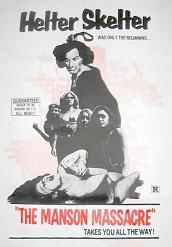 This is the great lost film of Manson mythology, having seemingly dropped off the face of the Earth after theatrical runs under at least two different titles. Aside from the excellent exploitation artwork of the poster, this film’s greatest asset is an uncredited appearance by large breasted Russ Myer actress Uschi Digard. While the hard working actress had been in a long string of soft-core porn films by this point in her career, her break out film, Meyer’s Supervixens, was still a few years off. German language prints have recently surfaced so hopefully one day Manson movie completists will be able to add this one to their shelves.
This is the great lost film of Manson mythology, having seemingly dropped off the face of the Earth after theatrical runs under at least two different titles. Aside from the excellent exploitation artwork of the poster, this film’s greatest asset is an uncredited appearance by large breasted Russ Myer actress Uschi Digard. While the hard working actress had been in a long string of soft-core porn films by this point in her career, her break out film, Meyer’s Supervixens, was still a few years off. German language prints have recently surfaced so hopefully one day Manson movie completists will be able to add this one to their shelves.
Manson (1973)
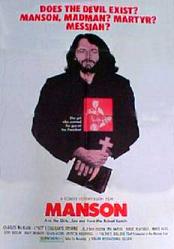 Immediately following the apprehension of the principal suspects in the Tate-LaBianca murders, documentary filmmaker Robert Hendrickson took a camera crew to Spahn Ranch to interview the other members of The Family. Over thirty-five years later this still stands as some of the most revealing footage of this rag tag bunch of outcasts and their nihilistic views on society at that time. Some of the interviews border on humorous as members discuss their drug use with complete ignorance of the potency of what they were ingesting. It is also shocking to see the antisocial and sometimes violent mindset many were in. Hendrickson represents the incarcerated members through news footage and dedicates time to supporting characters like prosecutor Vincent Bugliosi and prostitute Ronnie Howard, Susan Atkins’ cell mate who tipped off the police to her confessions and was receiving death threats at the time of filming. While the documentary can be disjointed at times and clearly appears rushed, it still presents an informative look at the members of the group behind the murders and many of the participants were later arrested for other crimes. Manson received an Oscar nomination in 1973 for Best Documentary Feature.
Immediately following the apprehension of the principal suspects in the Tate-LaBianca murders, documentary filmmaker Robert Hendrickson took a camera crew to Spahn Ranch to interview the other members of The Family. Over thirty-five years later this still stands as some of the most revealing footage of this rag tag bunch of outcasts and their nihilistic views on society at that time. Some of the interviews border on humorous as members discuss their drug use with complete ignorance of the potency of what they were ingesting. It is also shocking to see the antisocial and sometimes violent mindset many were in. Hendrickson represents the incarcerated members through news footage and dedicates time to supporting characters like prosecutor Vincent Bugliosi and prostitute Ronnie Howard, Susan Atkins’ cell mate who tipped off the police to her confessions and was receiving death threats at the time of filming. While the documentary can be disjointed at times and clearly appears rushed, it still presents an informative look at the members of the group behind the murders and many of the participants were later arrested for other crimes. Manson received an Oscar nomination in 1973 for Best Documentary Feature.
Helter Skelter (1976)
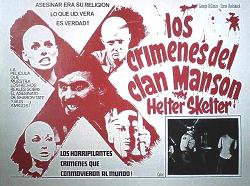 In 1974, California District Attorney Vincent Bugliosi published a book recounting the investigation of the Tate-Labianca murders and the subsequent prosecution of Charles Manson and his accomplices. The book was a best seller and two years later, a two part miniseries based on his accounts made a major impact on American television audiences. This film takes a very somber and factual approach to its grim subject matter and benefits tremendously from the spot on performances of George DiCenzo as Bugliosi and a young actor named Steve Railsback as Manson. Helter Skelter attempts to accurately portray the brutality of the murders without exploiting them. Much of the screen time is devoted to the police investigation, including many of their oversights, and the court room trial that Manson attempted to disrupt as often as possible. This was also the first film to explore the Beatles connection and it features their music performed by the cover band Rain. By the time this aired, the death sentences awarded to Manson and his followers had been commuted to life in prison when the state of California abolished the death penalty in 1972. For foreign markets, a slightly racier version of the miniseries was edited into a feature film and distributed theatrically. For anyone interested in a concise version of the case and trail, this remains the final word.
In 1974, California District Attorney Vincent Bugliosi published a book recounting the investigation of the Tate-Labianca murders and the subsequent prosecution of Charles Manson and his accomplices. The book was a best seller and two years later, a two part miniseries based on his accounts made a major impact on American television audiences. This film takes a very somber and factual approach to its grim subject matter and benefits tremendously from the spot on performances of George DiCenzo as Bugliosi and a young actor named Steve Railsback as Manson. Helter Skelter attempts to accurately portray the brutality of the murders without exploiting them. Much of the screen time is devoted to the police investigation, including many of their oversights, and the court room trial that Manson attempted to disrupt as often as possible. This was also the first film to explore the Beatles connection and it features their music performed by the cover band Rain. By the time this aired, the death sentences awarded to Manson and his followers had been commuted to life in prison when the state of California abolished the death penalty in 1972. For foreign markets, a slightly racier version of the miniseries was edited into a feature film and distributed theatrically. For anyone interested in a concise version of the case and trail, this remains the final word.
